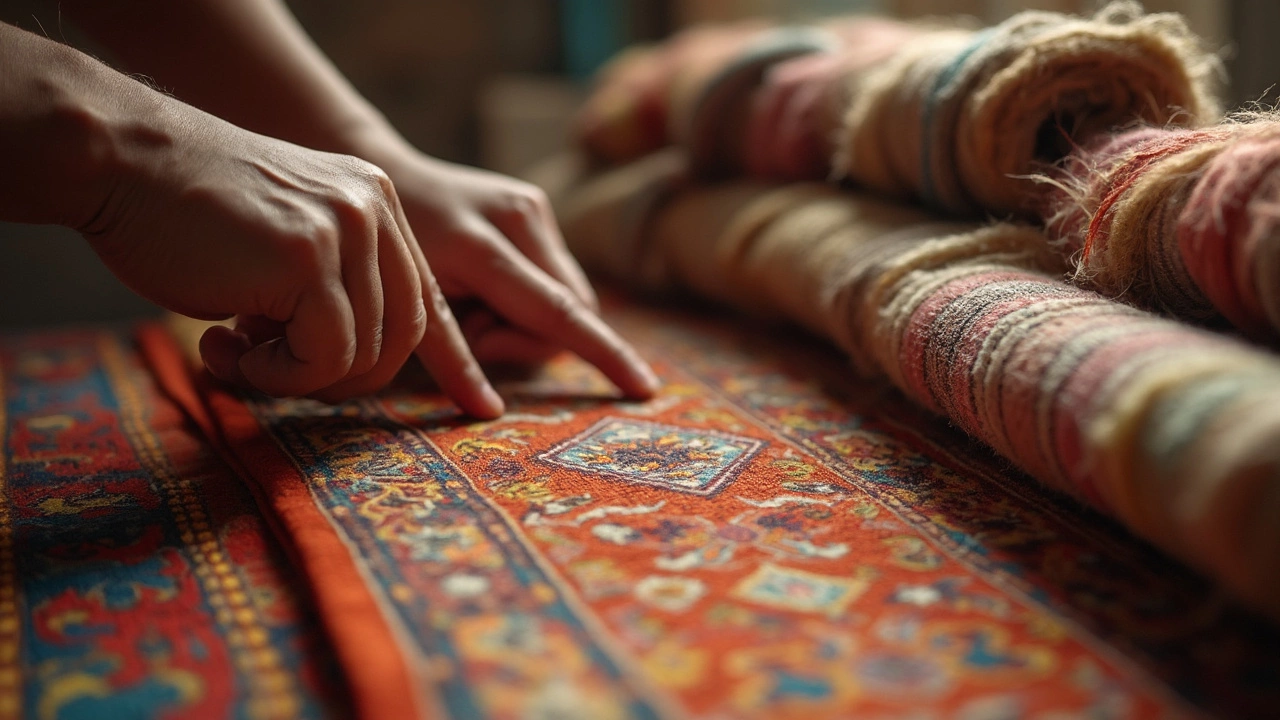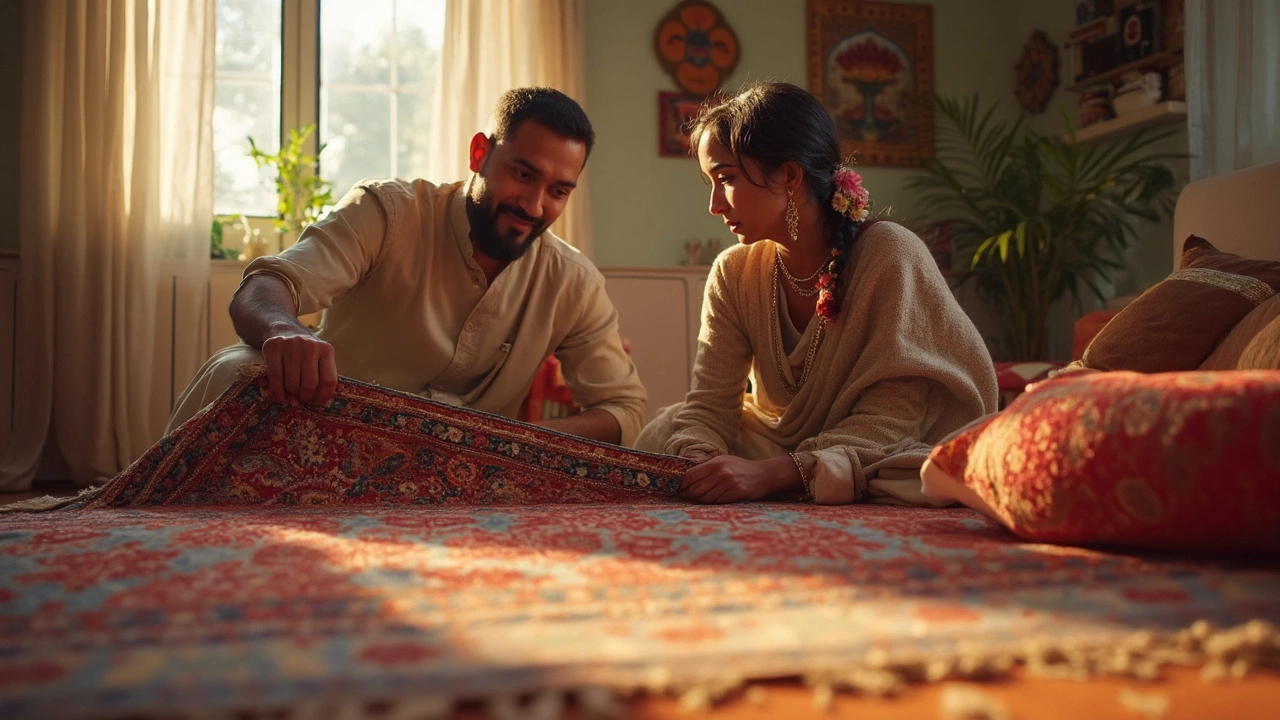Ever find yourself staring at a rug and wondering if it’s actually worth the price? You’re definitely not alone. With so many options out there, it’s tough to know what counts as real quality and what’s just clever marketing. Here’s the thing—most people miss the signs that really matter.
Start with the material. Wool rugs usually hold up best and feel great underfoot, while silk adds shine but is less durable for busy spots. If a rug feels scratchy or plasticky, it’s probably made with synthetic fibers. These might cost less, but they tend to flatten and wear out faster. Get hands-on in the store—rub your hand over the surface. A quality rug will feel dense and spring back, not limp or flaky.
- Material Matters Most
- Look at the Weave and Knots
- Inspect the Edges and Back
- Practical Tests and Red Flags
Material Matters Most
If you want a rug quality check that actually tells you something, start with what the rug is made of. There’s a huge difference between natural and synthetic fibers. Wool is easily the top choice for most folks. It's naturally stain-resistant, tough against foot traffic, and has a softness that holds up for years. Hand-knotted wool rugs can last over 50 years if you treat them right. Silk is another natural fiber that gives a rug a shiny, smooth look—though it’s better on walls or in fancy rooms than in a hallway, since it wears down quickly under shoes and paws.
Cotton rugs are less expensive and make for great flatweaves, but they pick up stains and shrink faster, so think twice if you’re putting them in a busy room. Jute, sisal, and other plant-based materials feel rougher, but they’re great for a natural, beachy style—just don’t expect them to survive a spilled cup of coffee.
Synthetic fibers like nylon, polyester, and polypropylene are everywhere because they're cheap and resist stains pretty well. But here’s the catch: these rugs usually look worn out much faster, flatten easily, and can feel plasticky. That bargain tag comes with a trade-off in both looks and lifespan.
Here’s a quick cheat sheet:
- Wool: Best mix of comfort, durability, and appearance; more expensive upfront.
- Silk: Luxury look, but only for low-traffic spots.
- Cotton: Budget-friendly, easy to clean, wears faster.
- Jute/Sisal: Natural vibe, super textured, not great with moisture or stains.
- Synthetics: Affordable, resists basic stains, but doesn’t last as long and can feel fake.
If you don’t know what your rug is made of, check the label or flip it over and look for how the fibers are attached. High-quality materials usually go hand-in-hand with better craftsmanship and longer lifespan. And if you have allergies, stick to natural fibers—they trap fewer allergens compared to the typical cheap synthetic rugs.
Look at the Weave and Knots
The way a rug is woven or knotted says a ton about its rug quality. Hand-knotted rugs, especially those from places like Iran or India, usually mean serious craftsmanship. You’ll often hear people talk about “knot count”—that’s basically how many knots are packed into each square inch. More knots? That means more time and care went into making it, and the rug will usually look sharper and last longer. Handmade Persian rugs, for example, often range from 120 to over 800 knots per square inch.
To check for yourself, flip the rug over. You should see a clean, clear pattern on the back that matches the front if it’s hand-knotted. If the back looks totally different or there’s a layer of glued mesh, you’re probably looking at a machine-made or tufted rug. Those are fine for a bargain, but they don’t have the staying power of something hand-knotted or hand-woven.
Here’s a quick way to spot the difference:
- Hand-knotted rugs: Closely packed knots, matching pattern front and back, no glue or mesh.
- Hand-woven rugs: Flat weave, you can see the structure on both sides, often lighter and more flexible.
- Machine-made rugs: Perfectly even stitches, often backed with latex or mesh fabric, pattern may not be as crisp on the back.
If you’re eyeing real durable rugs, a tight weave and a high knot count are your best friends. Loose or uneven weaves can mean shortcuts in production, which usually means a shorter life for your rug.

Inspect the Edges and Back
Most shoppers focus on the top side, but if you’re serious about rug quality, the edges and back tell the real story. First up: check the binding on the edges. High-quality rugs have tight, even stitching that hugs the rug all the way around. If you spot loose threads or fraying, it’s a red flag the rug won’t last. Hand-knotted rugs almost always have finished edges done by hand, while machine-made rugs sometimes have glued or surge-stitched edges that can unravel fast.
Flip the rug over. On a hand-knotted rug, the pattern on the back should look almost like the front, just with smaller knots or tiny bumps. That’s your sign the design was actually woven, not just printed. Machine-made rugs tend to have a plastic or mesh backing with a pattern that looks blurry or totally different from the front. Sometimes, you’ll even see rough glue spots or backing fabric that’s peeling up—skip those if you want durability.
Laying the rug flat is another easy test. Quality rugs sit flat all the way around. If the edges curl up or the corners lift, the materials or workmanship are probably lacking. Rugs that start curling or warping after a few weeks usually mean shortcuts were taken during production.
- If you see knots or weft threads on the back, that’s a strong sign of a hand-made rug.
- A crisp, clean stitch along the border means the rug can take real-life use without falling apart.
- If the binding is obviously glued rather than stitched, chances are the rug won’t handle heavy foot traffic or cleaning.
Here’s something practical: when you roll up a quality rug, it’s flexible and holds its shape—no cracking noises, no stiff feeling. Low-quality rugs might feel rigid or even make a crunching sound because of cheap fillers or glue.
| Feature | High-Quality Rug | Low-Quality Rug |
|---|---|---|
| Stitching/Borders | Hand-stitched, tight | Glued/loose, uneven |
| Back Pattern | Clear, mirrors front | Blurry, hidden by mesh |
| Flexibility | Rolls easily, no cracks | Stiff, cracks/noisy |
Next time you look at a rug, don’t be shy—peek at the back, check those edges, and give it a roll. These quick checks can save you a ton of money (and headaches) later on.
Practical Tests and Red Flags
Alright, it's time to get hands-on with your rug. These quick checks can really separate a good rug from a dud, especially if you're after rug quality but want proof.
- Lift and Bend Test: Grab a corner and bend it up toward the ceiling. If the rug folds easily, it means it's got a looser weave—these can wear out quicker. A quality, dense pile will resist folding and feel sturdy.
- Shed Test: Rub your palm back and forth over the rug for a few seconds. Some fuzz is normal for a new wool rug, but if clumps come out or you see lots of loose fibers, that’s a clear sign the construction isn’t solid. For durable rugs, shedding fades with use—not in handfuls from day one.
- Colorfastness: Dab a damp white cloth on the rug. If dye comes off onto the cloth, that color will fade fast, and you’ll likely see issues after the first cleaning or spill.
- Odor Check: Good rugs shouldn’t smell like chemicals or plastic. A strong odor usually means there are synthetic glues or sealants, which isn’t a great sign.
- Edge Inspection: Run your finger along the edges. Hand-stitched or well-finished edges roller smoothly and tightly. Loose threads, unraveling, or visible glue are red flags for poor rug quality.
Some problems are easy to miss until it’s too late. Look out for these:
- If the rug’s backing is rubbery and peels off or cracks, it’s usually a synthetic with a short lifespan.
- Fold the rug and look at the design on the back. A quality rug will show a clear pattern, not just a faded, blurry mess. This is especially true in hand-knotted and good machine-made rugs.
- Check the label. If it doesn’t clearly list materials like wool, silk, or cotton—or just says “viscose,” “polyester,” or “rayon”—expect less durability.
If you’re still not sure, ask about the rug’s warranty or return policy. Reputable sellers of how to spot good rug brands will stand behind what they sell. No return option? That’s usually not a good sign.
